
uTensor
TinyML AI inference library
Stars: 1693
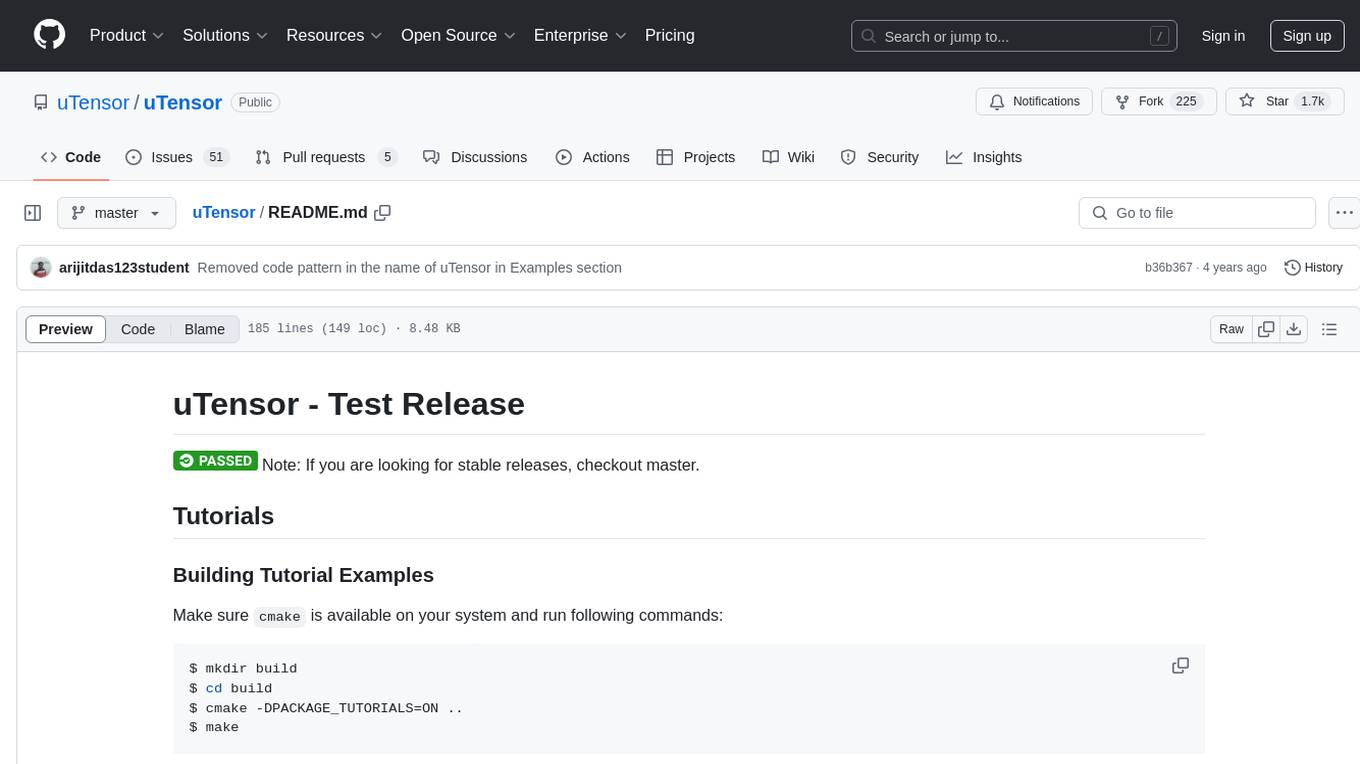
uTensor is an extremely light-weight machine learning inference framework built on Tensorflow and optimized for Arm targets. It consists of a runtime library and an offline tool that handles most of the model translation work. The core runtime is only ~2KB. The workflow involves constructing and training a model in Tensorflow, then using uTensor to produce C++ code for inferencing. The runtime ensures system safety, guarantees RAM usage, and focuses on clear, concise, and debuggable code. The high-level API simplifies tensor handling and operator execution for embedded systems.
README:
Note: If you are looking for stable releases, checkout master.
Make sure cmake is available on your system and run following commands:
$ mkdir build
$ cd build
$ cmake -DPACKAGE_TUTORIALS=ON ..
$ makeAfter the building process finish, you should find the tutorial executables under build/tutorials/ directory.
Follow instructions in the README.md in each tutorial directories to learn how to use uTensor.
Here are the links to the tutorials:
uTensor is an extremely light-weight machine learning inference framework built on Tensorflow and optimized for Arm targets. It consists of a runtime library and an offline tool that handles most of the model translation work. This repo holds the core runtime and some example implementations of operators, memory managers/schedulers, and more, and the size of the core runtime is only ~2KB!
| Module | .text | .data | .bss |
|---|---|---|---|
| uTensor/src/uTensor/core | 1275(+1275) | 4(+4) | 28(+28) |
| uTensor/src/uTensor/tensors | 791(+791) | 0(+0) | 0(+0) |
A model is constructed and trained in Tensorflow. uTensor takes the model and produces a .cpp and .hpp file. These files contains the generated C++11 code needed for inferencing. Working with uTensor on the embedded side is as easy as copy-and-paste.
Check out the detailed description here
The rearchitecture is fundamentally centered around a few key ideas, and the structure of the code base and build tools naturally followed. Old key points:
- Tensors describe how data is accessed and where from
- Performance of ops depends on which tensors are used
- Operators are Tensor agnostic
- High performance ops can fetch blocks of data at once
- Strive for low total power in execution
- Low static and dynamic footprint, be small
- Low cost per Tensor throughout the entire system, since most generated models have 100+ including intermediates, also impacts dynamic footprint
- Lightweight class hierarchy
- Duh
New additional key ideas:
- System safety
- All tensor metadata and actual data are owned in dedicated regions
- This can either be user provided, or one we create
- We can guarantee that runtime will use no more than N bytes of RAM at code gen time or at compile time!
- Generally should not collide with userspace or system space memory, i.e. dont share heaps
- Generally implications: a safe runtime means we can safely update models remotely
- As many compile time errors as possible!
- Mismatched inputs, outputs, or numbers
- wrong sizes used
- Impossible memory accesses
- etc.
- All tensor metadata and actual data are owned in dedicated regions
- Clear, Concise, and Debuggable
- Previous iteration of uTensor relied almost too heavily on codegen, making changes to a model for any reason was near impossible
- A developer should be able to make changes to the model without relying on code gen
- A developer should be able to look at a model file and immediately understand what the graph looks like, without a massive amound of jumping around
- Default tensor interface should behave like a higher level language, but exploit the speed of C++
- Generally: No more pointer bullshit! C is super error prone, fight me
- Only specialized operators have access to raw data blocks, and these ops will be wicked fast
- Generally: No more pointer bullshit! C is super error prone, fight me
- Extensible, configurable, and optimize-outable error handling
- GDB debugging IS NOW TRIVIAL
As mentioned before, these key ideas need to be reflected not only in the code, but in the code structure in such a way that it is Maintainable, Hackable, and User-extensible. Pretty much everything in the uTensor runtime can be divided into two components: core, and everything else. The core library contains all the deep low level functionality needed for the runtime to make the above guarantees, as well as the interfaces required for concrete implementation. Furthermore, the overhead of this core engine should be negligible relative to the system operation. Everything not in the core library really should just be thought of a reasonable defaults. For example, tensor implementations, default operators, example memory allocators, or even possible logging systems and error handlers. These modules should be the primary area for future optimization, especially before model deployment.
using namespace uTensor;
const uint8_t s_a[4] = {1, 2, 3, 4};
const uint8_t s_b[4] = {5, 6, 7, 8};
const uint8_t s_c_ref[4] = {19, 22, 43, 50};
// These can also be embedded in models
// Recommend, not putting these on the heap or stack directly as they can be large
localCircularArenaAllocator<256> meta_allocator; // All tensor metadata gets stored here automatically, even when new is called
localCircularArenaAllocator<256> ram_allocator; // All temporary storage gets allocated here
void foo() {
// Tell the uTensor context which allocators to use
Context::get_default_context()->set_metadata_allocator(&meta_allocator);
Context::get_default_context()->set_ram_data_allocator(&ram_allocator);
// Tensors are simply handles for accessing data as necessary, they are no larger than a pointer
// RomTensor(TensorShape, data_type, data*);
Tensor a = new /*const*/ RomTensor({2, 2}, u8, s_a);
Tensor b = new /*const*/ RomTensor({2, 2}, u8, s_b);
Tensor c_ref = new RomTensor({2,2}, u8, s_c_ref);
// RamTensors are held internally and can be moved or cleared depending on the memory schedule (optional)
Tensor c = new RamTensor({2, 2}, u8);
// Operators take in a fixed size map of (input_name -> parameter), this gives compile time errors on input mismatching
// Also, the name binding + lack of parameter ordering makes ctag jumping and GDB sessions significantly more intuitive
MatrixMultOperator<uint8_t> mult_AB;
mult_AB
.set_inputs({{MatrixMultOperator<uint8_t>::a, a}, {MatrixMultOperator<uint8_t>::b, b}})
.set_outputs({{MatrixMultOperator<uint8_t>::c, c}})
.eval();
// Compare results
TensorShape& c_shape = c->get_shape();
for (int i = 0; i < c_shape[0]; i++) {
for (int j = 0; j < c_shape[1]; j++) {
// Just need to cast the access to the expected type
if( static_cast<uint8_t>(c(i, j)) != static_cast<uint8_t>(c_ref(i, j)) ) {
printf("Oh crap!\n");
exit(-1);
}
}
}
}git clone [email protected]:uTensor/uTensor.git
cd uTensor/
git checkout proposal/rearch
git submodule init
git submodule update
mkdir build
cd build/
cmake -DPACKAGE_TESTS=ON -DCMAKE_BUILD_TYPE=Debug ..
make
make test
The uTensor core library is configured as a mbed library out of the box, so we just need to import it into our project and build as normal.
mbed new my_project
cd my_project
mbed import https://github.com/uTensor/uTensor.git
# Create main file
# Run uTensor-cli workflow and copy model directory here
mbed compile # as normal
TODO Note: CMake Support for Arm is currently experimental https://stackoverflow.com/questions/46916611/cross-compiling-googletest-for-arm64
Default build
mkdir build && cd build
cmake -DCMAKE_BUILD_TYPE=Debug -DCMAKE_TOOLCHAIN_FILE=../extern/CMSIS_5/CMSIS/DSP/gcc.cmake ..
With CMSIS optimized kernels
mkdir build && cd build
cmake -DARM_PROJECT=1 -DCMAKE_BUILD_TYPE=Debug -DCMAKE_TOOLCHAIN_FILE=../extern/CMSIS_5/CMSIS/DSP/gcc.cmake ..
For Tasks:
Click tags to check more tools for each tasksFor Jobs:
Alternative AI tools for uTensor
Similar Open Source Tools

uTensor
uTensor is an extremely light-weight machine learning inference framework built on Tensorflow and optimized for Arm targets. It consists of a runtime library and an offline tool that handles most of the model translation work. The core runtime is only ~2KB. The workflow involves constructing and training a model in Tensorflow, then using uTensor to produce C++ code for inferencing. The runtime ensures system safety, guarantees RAM usage, and focuses on clear, concise, and debuggable code. The high-level API simplifies tensor handling and operator execution for embedded systems.
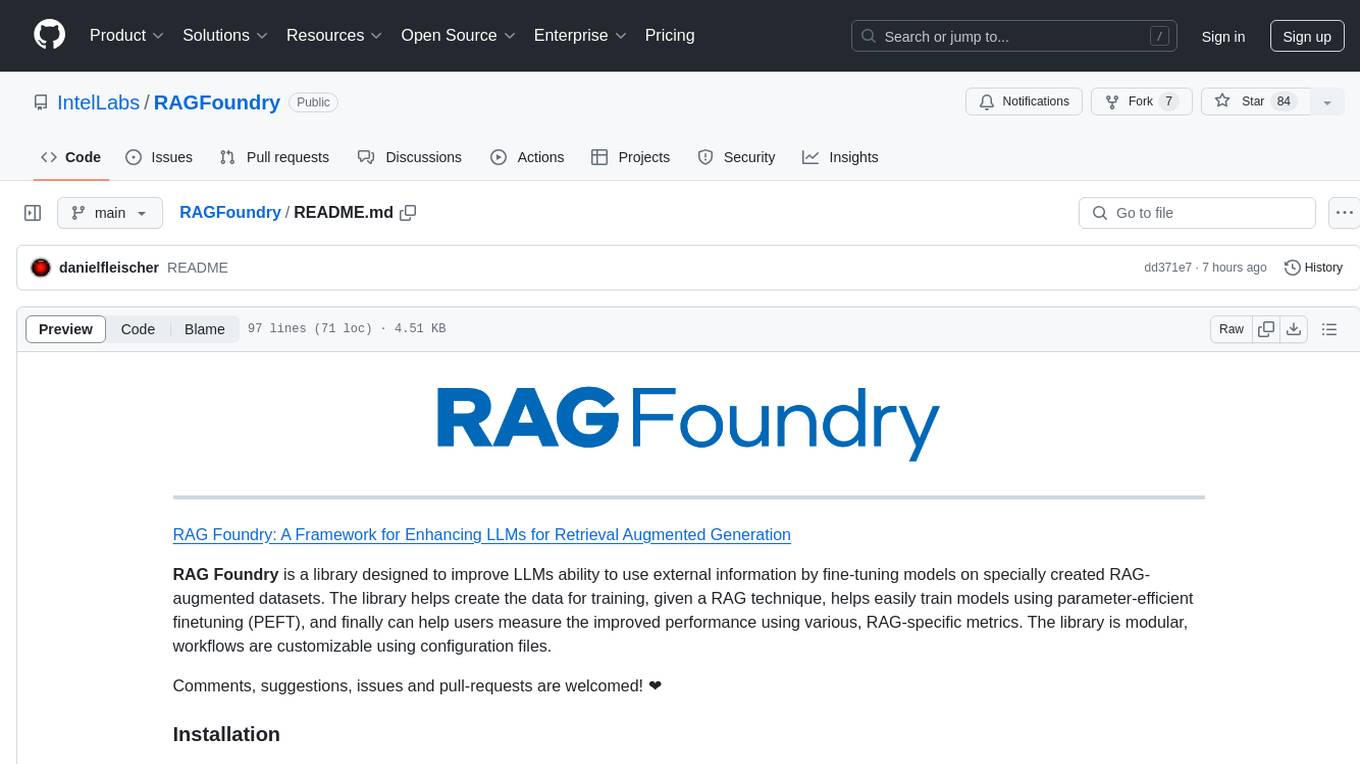
RAGFoundry
RAG Foundry is a library designed to enhance Large Language Models (LLMs) by fine-tuning models on RAG-augmented datasets. It helps create training data, train models using parameter-efficient finetuning (PEFT), and measure performance using RAG-specific metrics. The library is modular, customizable using configuration files, and facilitates prototyping with various RAG settings and configurations for tasks like data processing, retrieval, training, inference, and evaluation.
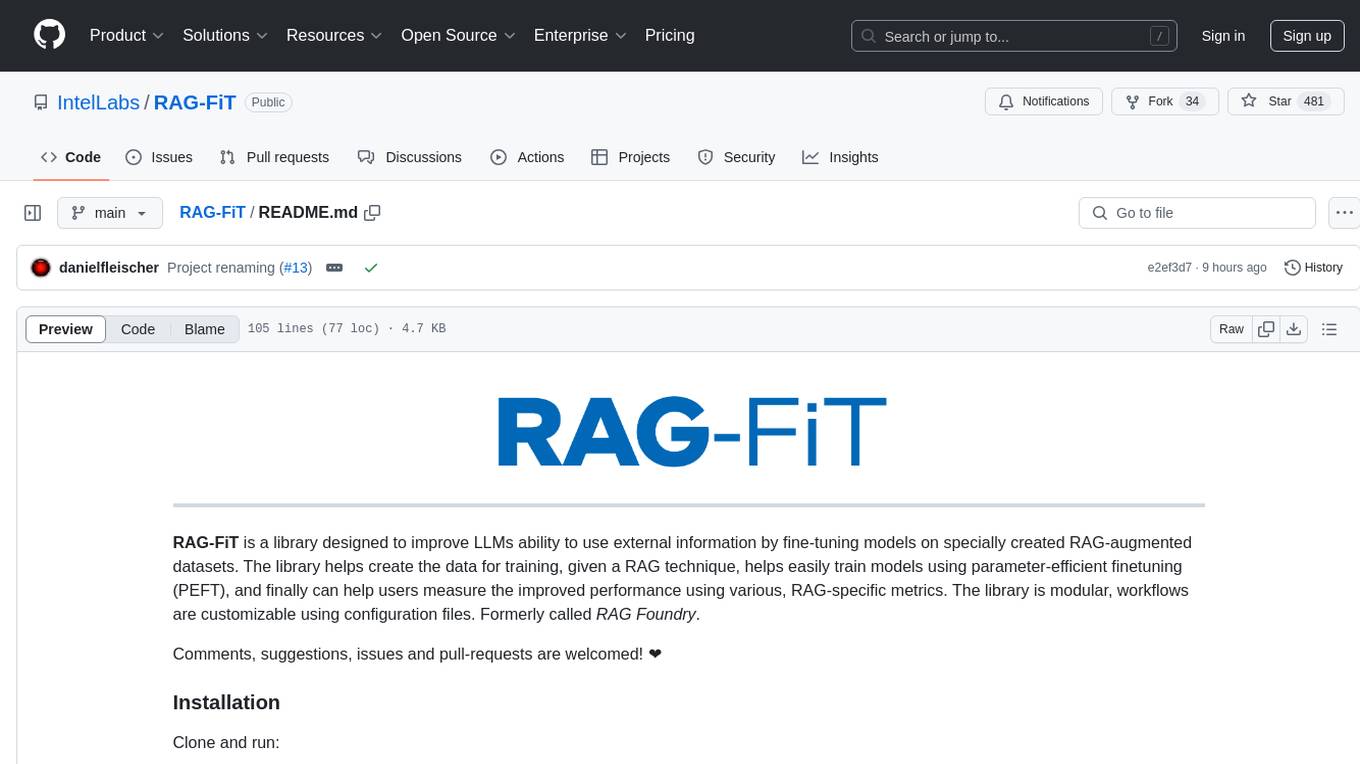
RAG-FiT
RAG-FiT is a library designed to improve Language Models' ability to use external information by fine-tuning models on specially created RAG-augmented datasets. The library assists in creating training data, training models using parameter-efficient finetuning (PEFT), and evaluating performance using RAG-specific metrics. It is modular, customizable via configuration files, and facilitates fast prototyping and experimentation with various RAG settings and configurations.
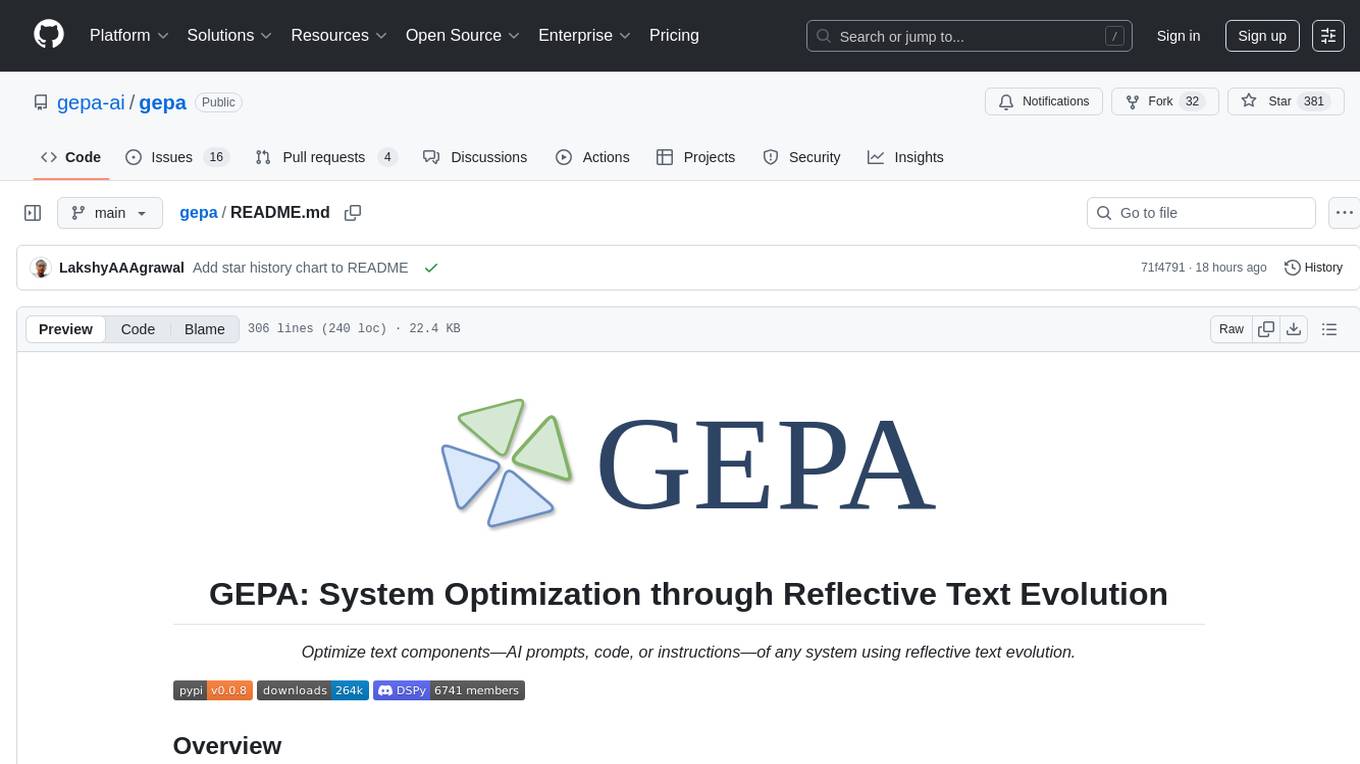
gepa
GEPA (Genetic-Pareto) is a framework for optimizing arbitrary systems composed of text components like AI prompts, code snippets, or textual specs against any evaluation metric. It employs LLMs to reflect on system behavior, using feedback from execution and evaluation traces to drive targeted improvements. Through iterative mutation, reflection, and Pareto-aware candidate selection, GEPA evolves robust, high-performing variants with minimal evaluations, co-evolving multiple components in modular systems for domain-specific gains. The repository provides the official implementation of the GEPA algorithm as proposed in the paper titled 'GEPA: Reflective Prompt Evolution Can Outperform Reinforcement Learning'.
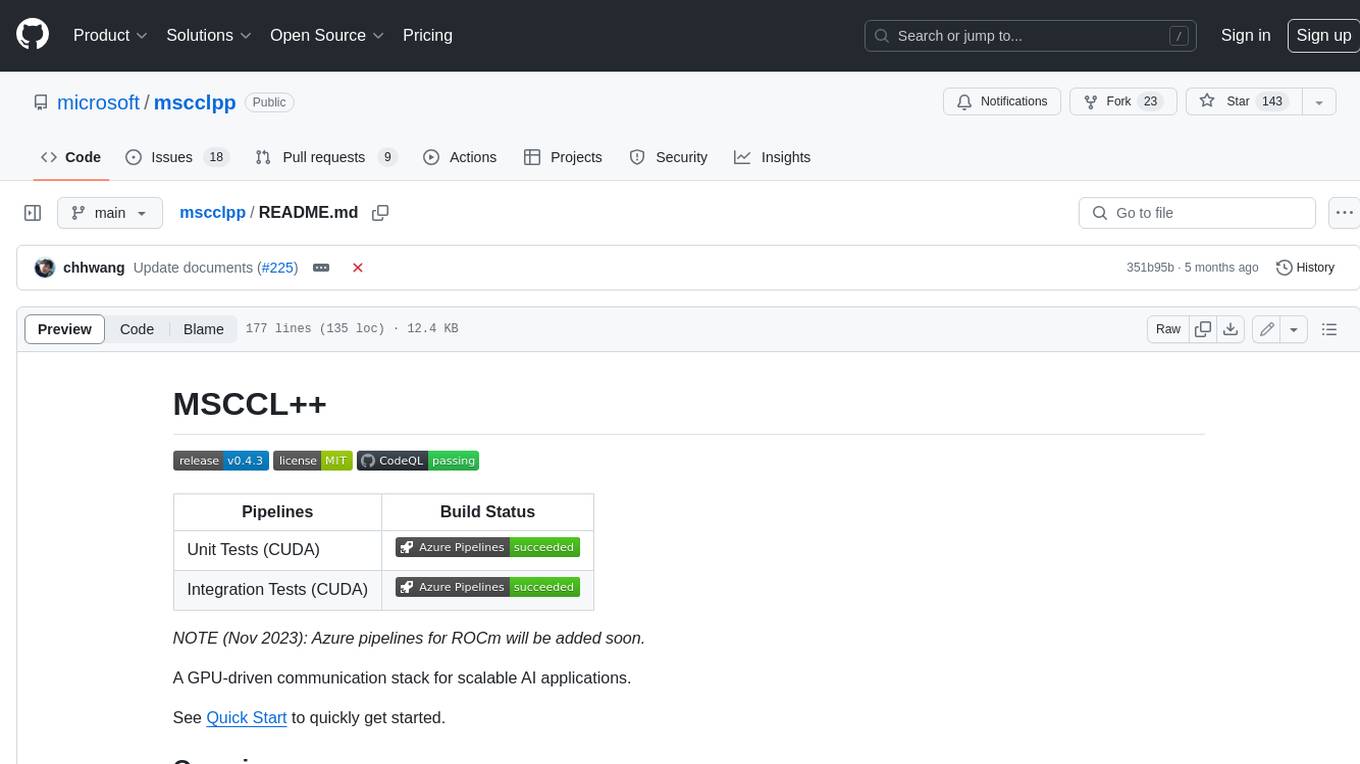
mscclpp
MSCCL++ is a GPU-driven communication stack for scalable AI applications. It provides a highly efficient and customizable communication stack for distributed GPU applications. MSCCL++ redefines inter-GPU communication interfaces, delivering a highly efficient and customizable communication stack for distributed GPU applications. Its design is specifically tailored to accommodate diverse performance optimization scenarios often encountered in state-of-the-art AI applications. MSCCL++ provides communication abstractions at the lowest level close to hardware and at the highest level close to application API. The lowest level of abstraction is ultra light weight which enables a user to implement logics of data movement for a collective operation such as AllReduce inside a GPU kernel extremely efficiently without worrying about memory ordering of different ops. The modularity of MSCCL++ enables a user to construct the building blocks of MSCCL++ in a high level abstraction in Python and feed them to a CUDA kernel in order to facilitate the user's productivity. MSCCL++ provides fine-grained synchronous and asynchronous 0-copy 1-sided abstracts for communication primitives such as `put()`, `get()`, `signal()`, `flush()`, and `wait()`. The 1-sided abstractions allows a user to asynchronously `put()` their data on the remote GPU as soon as it is ready without requiring the remote side to issue any receive instruction. This enables users to easily implement flexible communication logics, such as overlapping communication with computation, or implementing customized collective communication algorithms without worrying about potential deadlocks. Additionally, the 0-copy capability enables MSCCL++ to directly transfer data between user's buffers without using intermediate internal buffers which saves GPU bandwidth and memory capacity. MSCCL++ provides consistent abstractions regardless of the location of the remote GPU (either on the local node or on a remote node) or the underlying link (either NVLink/xGMI or InfiniBand). This simplifies the code for inter-GPU communication, which is often complex due to memory ordering of GPU/CPU read/writes and therefore, is error-prone.
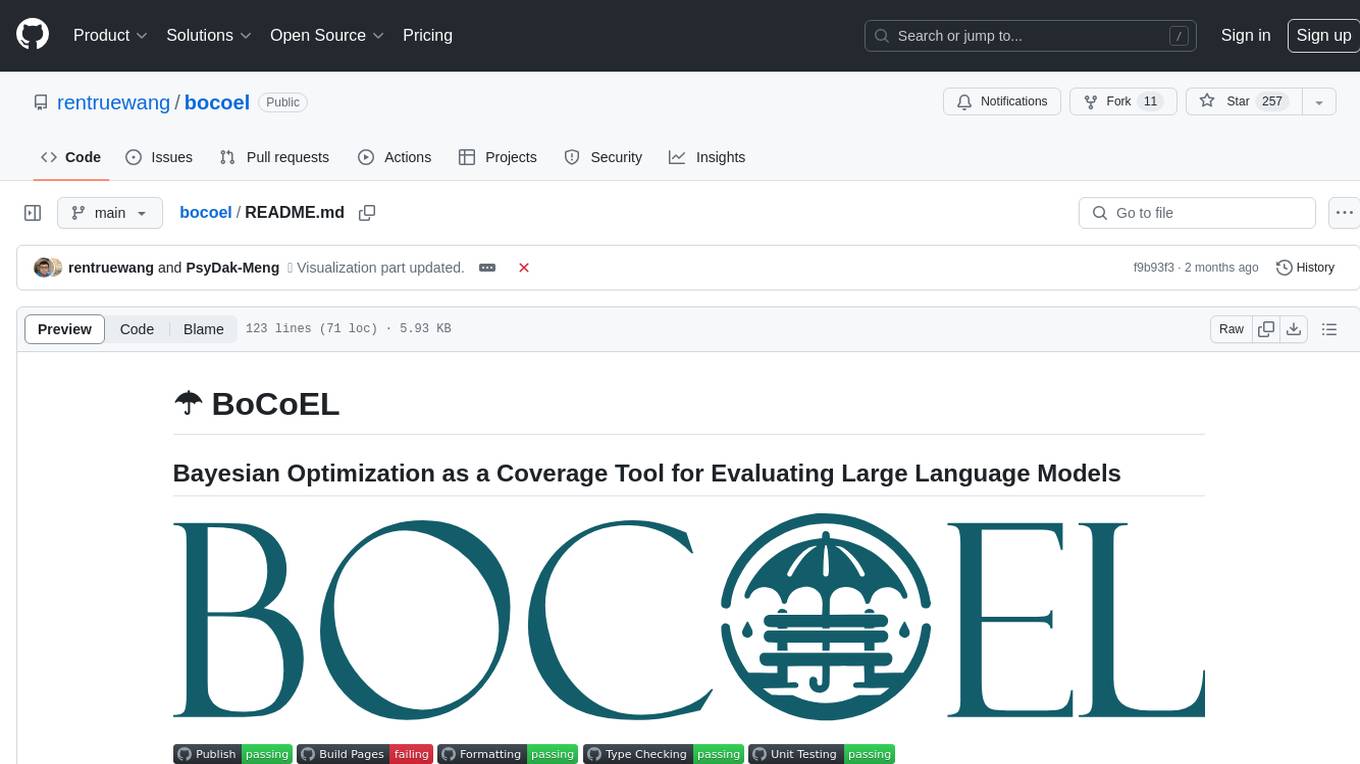
bocoel
BoCoEL is a tool that leverages Bayesian Optimization to efficiently evaluate large language models by selecting a subset of the corpus for evaluation. It encodes individual entries into embeddings, uses Bayesian optimization to select queries, retrieves from the corpus, and provides easily managed evaluations. The tool aims to reduce computation costs during evaluation with a dynamic budget, supporting models like GPT2, Pythia, and LLAMA through integration with Hugging Face transformers and datasets. BoCoEL offers a modular design and efficient representation of the corpus to enhance evaluation quality.
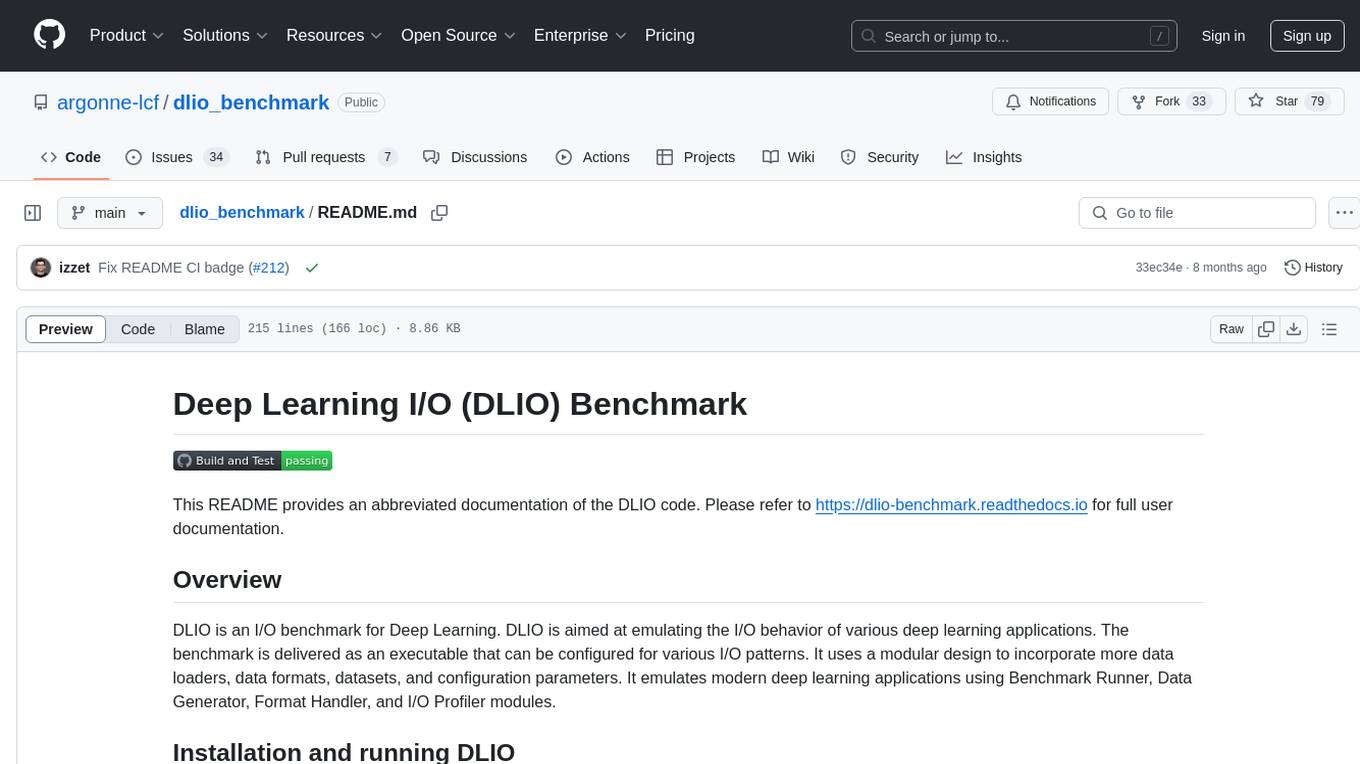
dlio_benchmark
DLIO is an I/O benchmark tool designed for Deep Learning applications. It emulates modern deep learning applications using Benchmark Runner, Data Generator, Format Handler, and I/O Profiler modules. Users can configure various I/O patterns, data loaders, data formats, datasets, and parameters. The tool is aimed at emulating the I/O behavior of deep learning applications and provides a modular design for flexibility and customization.
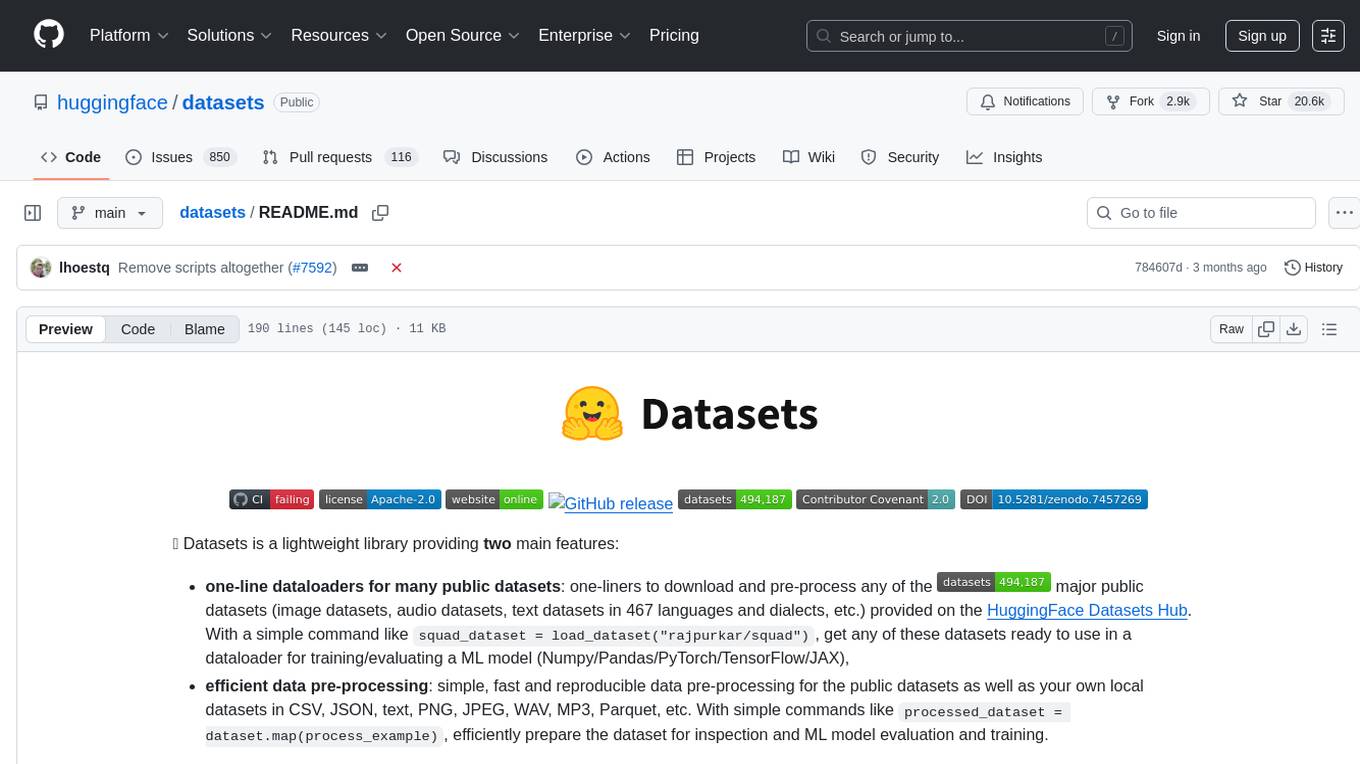
datasets
Datasets is a repository that provides a collection of various datasets for machine learning and data analysis projects. It includes datasets in different formats such as CSV, JSON, and Excel, covering a wide range of topics including finance, healthcare, marketing, and more. The repository aims to help data scientists, researchers, and students access high-quality datasets for training models, conducting experiments, and exploring data analysis techniques.
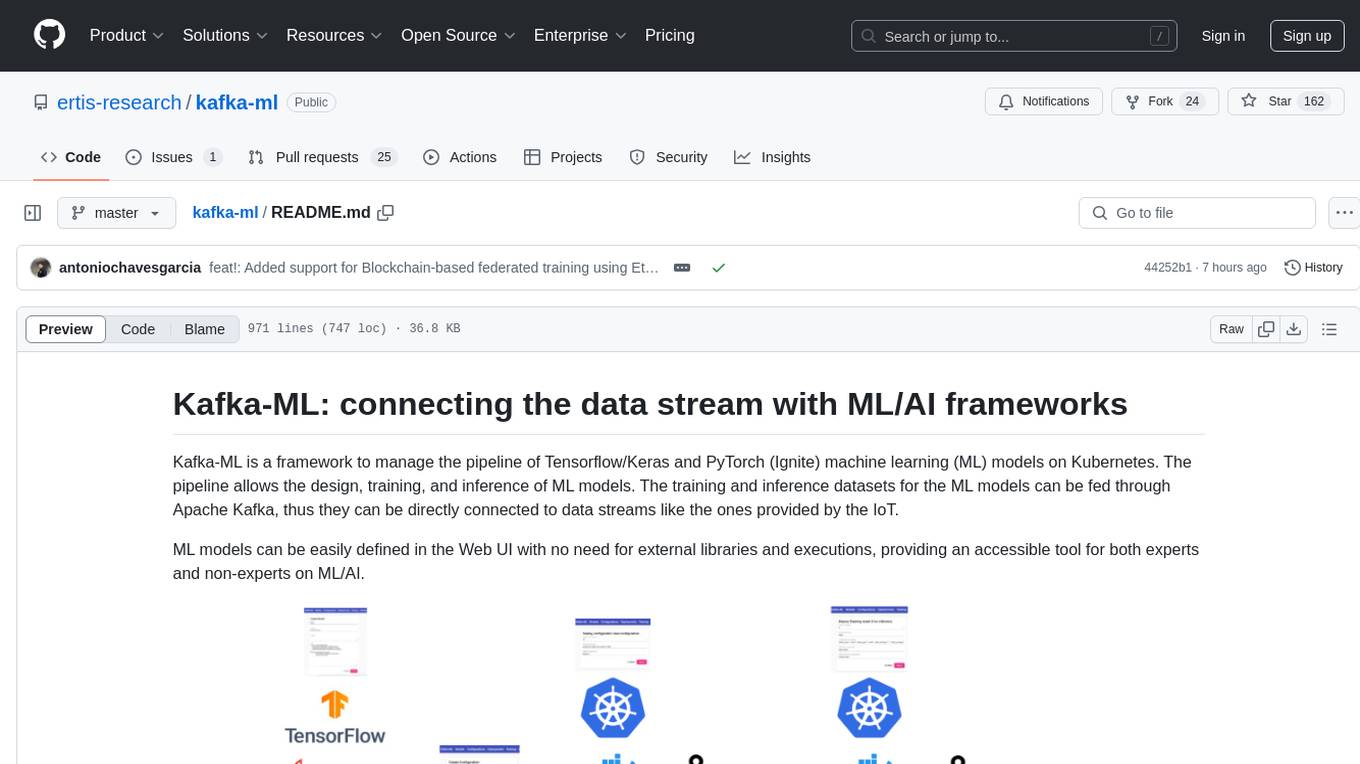
kafka-ml
Kafka-ML is a framework designed to manage the pipeline of Tensorflow/Keras and PyTorch machine learning models on Kubernetes. It enables the design, training, and inference of ML models with datasets fed through Apache Kafka, connecting them directly to data streams like those from IoT devices. The Web UI allows easy definition of ML models without external libraries, catering to both experts and non-experts in ML/AI.

llm_client
llm_client is a Rust interface designed for Local Large Language Models (LLMs) that offers automated build support for CPU, CUDA, MacOS, easy model presets, and a novel cascading prompt workflow for controlled generation. It provides a breadth of configuration options and API support for various OpenAI compatible APIs. The tool is primarily focused on deterministic signals from probabilistic LLM vibes, enabling specialized workflows for specific tasks and reproducible outcomes.
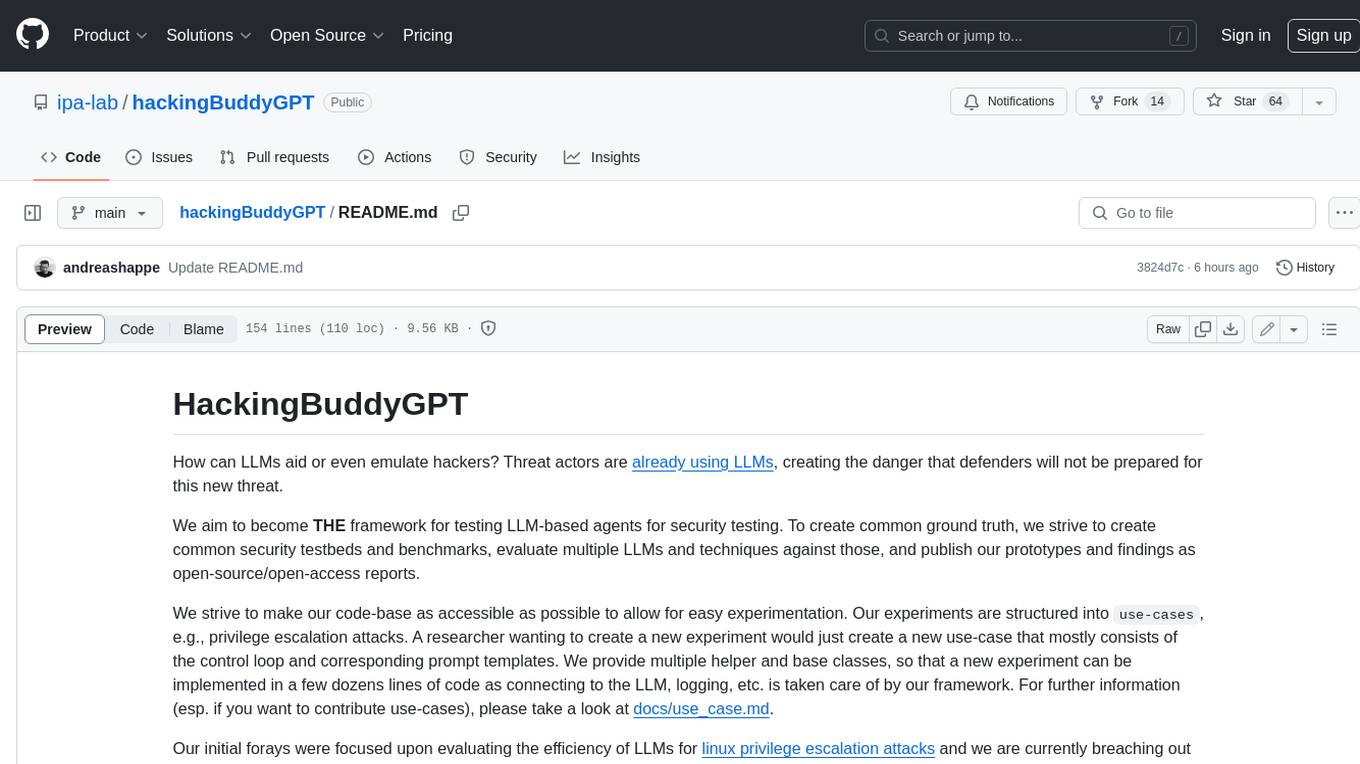
hackingBuddyGPT
hackingBuddyGPT is a framework for testing LLM-based agents for security testing. It aims to create common ground truth by creating common security testbeds and benchmarks, evaluating multiple LLMs and techniques against those, and publishing prototypes and findings as open-source/open-access reports. The initial focus is on evaluating the efficiency of LLMs for Linux privilege escalation attacks, but the framework is being expanded to evaluate the use of LLMs for web penetration-testing and web API testing. hackingBuddyGPT is released as open-source to level the playing field for blue teams against APTs that have access to more sophisticated resources.
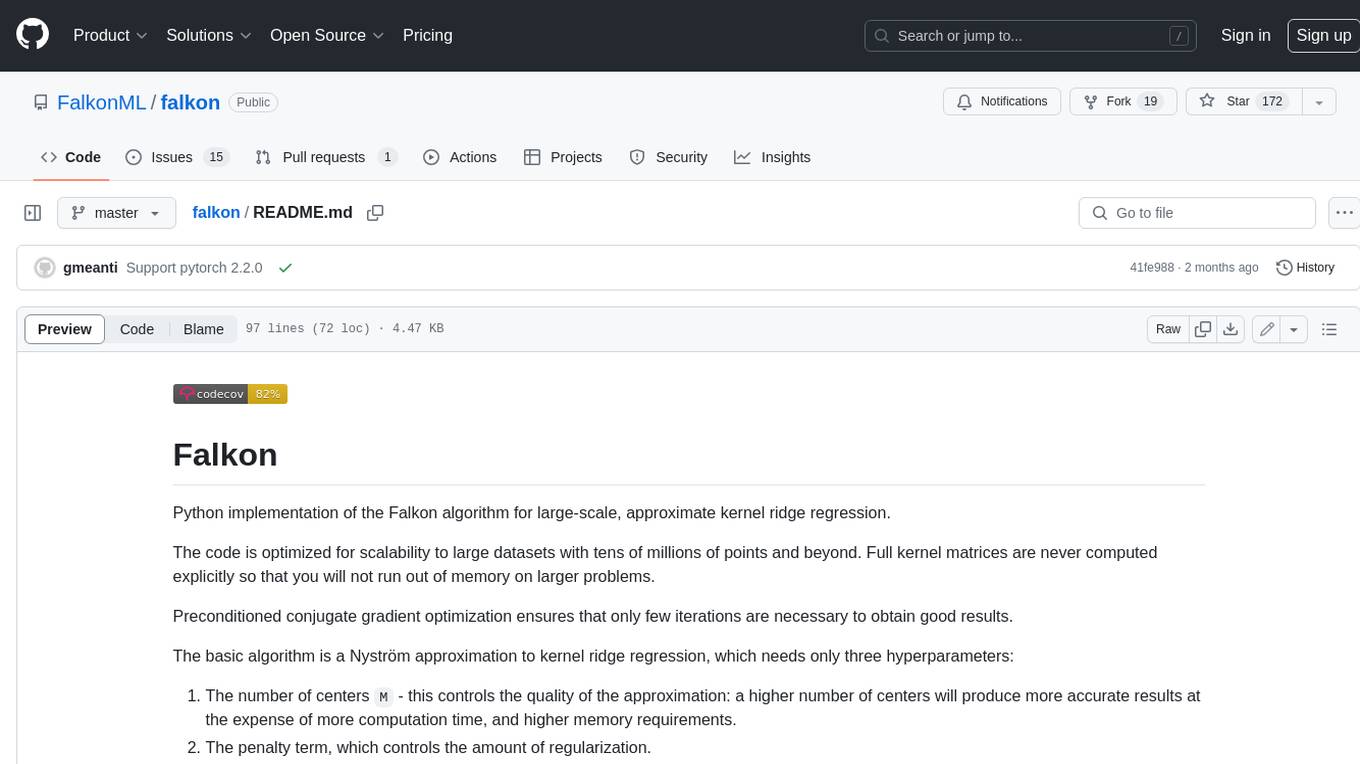
falkon
Falkon is a Python implementation of the Falkon algorithm for large-scale, approximate kernel ridge regression. The code is optimized for scalability to large datasets with tens of millions of points and beyond. Full kernel matrices are never computed explicitly so that you will not run out of memory on larger problems. Preconditioned conjugate gradient optimization ensures that only few iterations are necessary to obtain good results. The basic algorithm is a Nyström approximation to kernel ridge regression, which needs only three hyperparameters: 1. The number of centers M - this controls the quality of the approximation: a higher number of centers will produce more accurate results at the expense of more computation time, and higher memory requirements. 2. The penalty term, which controls the amount of regularization. 3. The kernel function. A good default is always the Gaussian (RBF) kernel (`falkon.kernels.GaussianKernel`).
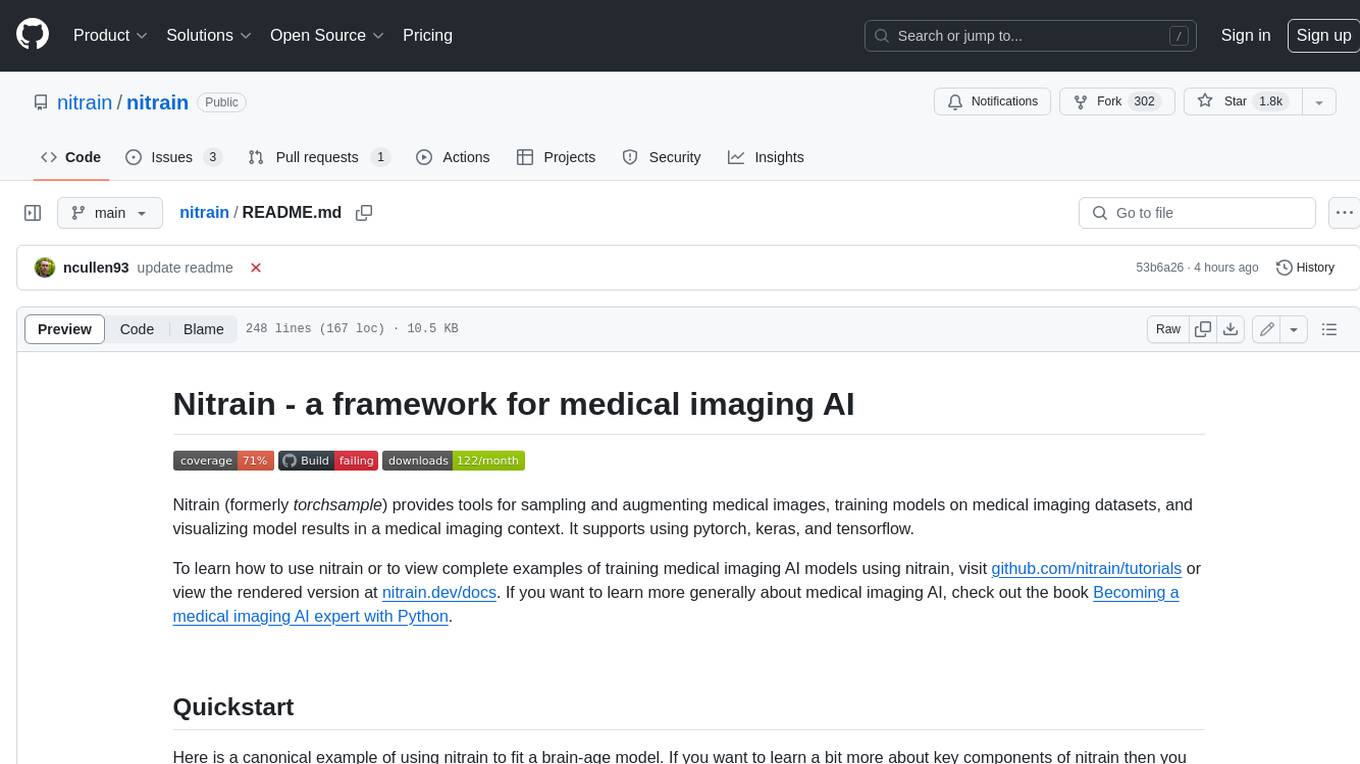
nitrain
Nitrain is a framework for medical imaging AI that provides tools for sampling and augmenting medical images, training models on medical imaging datasets, and visualizing model results in a medical imaging context. It supports using pytorch, keras, and tensorflow.
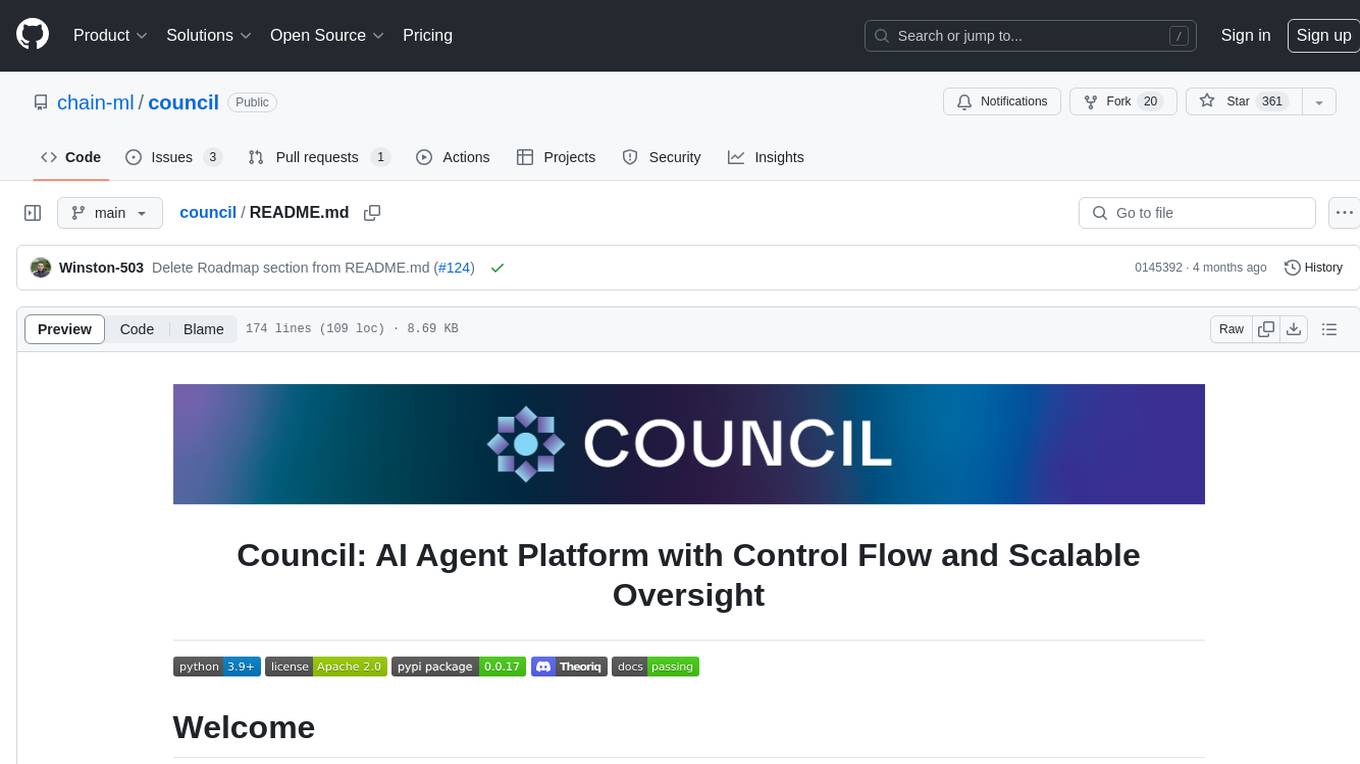
council
Council is an open-source platform designed for the rapid development and deployment of customized generative AI applications using teams of agents. It extends the LLM tool ecosystem by providing advanced control flow and scalable oversight for AI agents. Users can create sophisticated agents with predictable behavior by leveraging Council's powerful approach to control flow using Controllers, Filters, Evaluators, and Budgets. The framework allows for automated routing between agents, comparing, evaluating, and selecting the best results for a task. Council aims to facilitate packaging and deploying agents at scale on multiple platforms while enabling enterprise-grade monitoring and quality control.
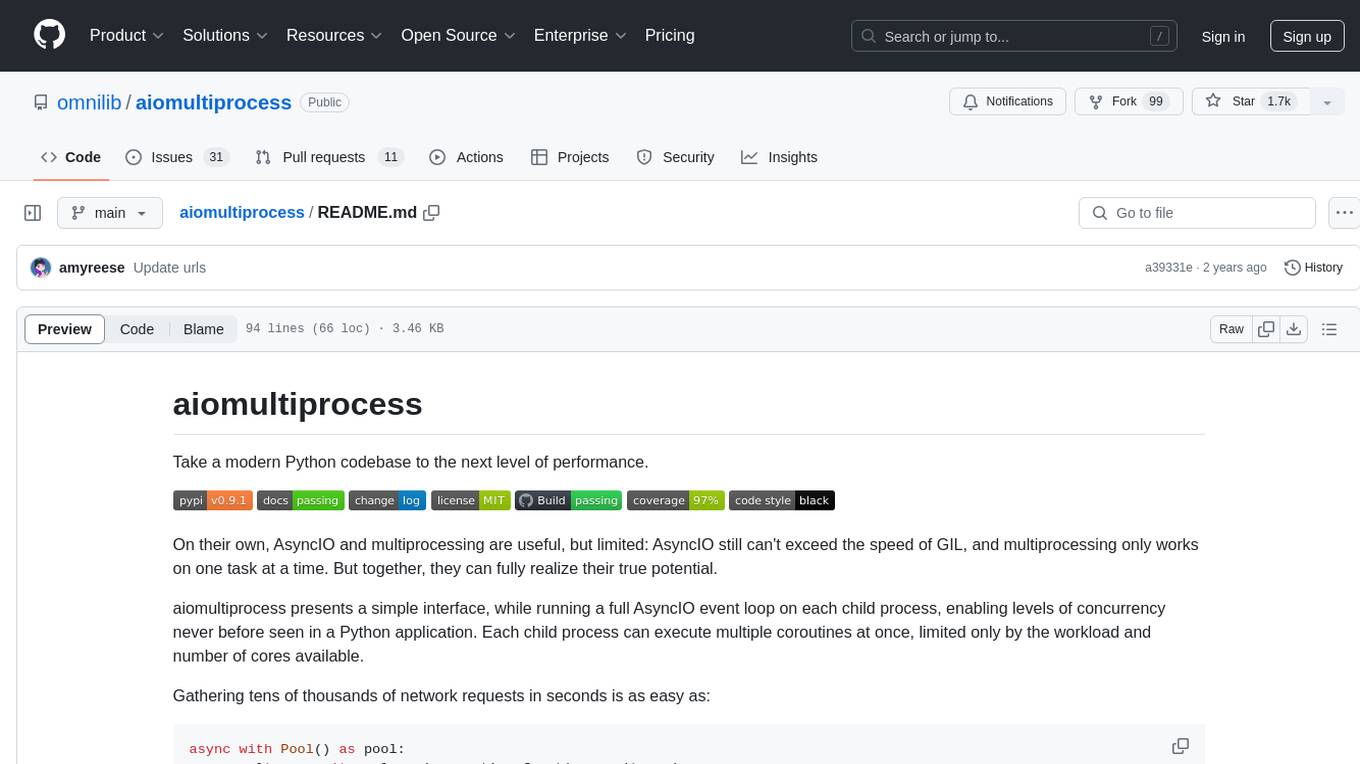
aiomultiprocess
aiomultiprocess is a Python library that combines AsyncIO and multiprocessing to achieve high levels of concurrency in Python applications. It allows running a full AsyncIO event loop on each child process, enabling multiple coroutines to execute simultaneously. The library provides a simple interface for executing asynchronous tasks on a pool of worker processes, making it easy to gather large amounts of network requests quickly. aiomultiprocess is designed to take Python codebases to the next level of performance by leveraging the combined power of AsyncIO and multiprocessing.
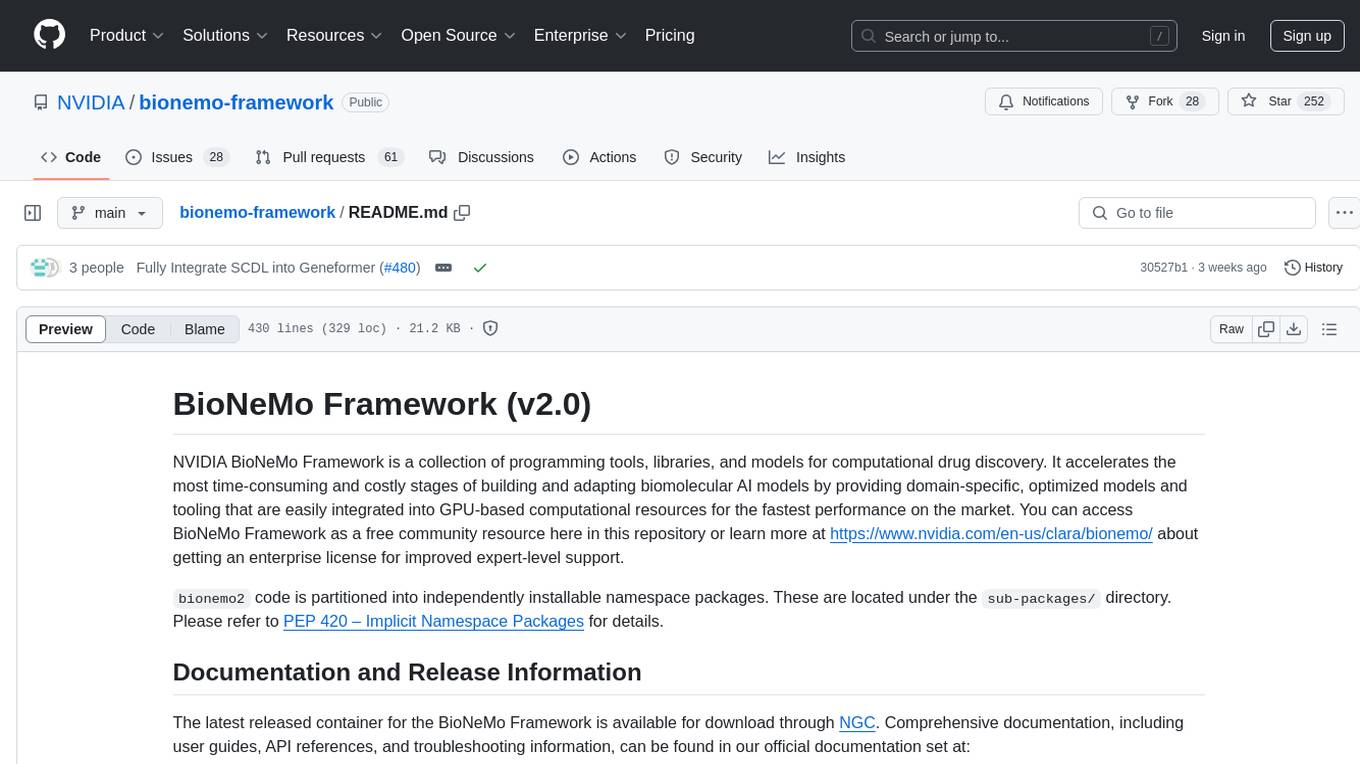
bionemo-framework
NVIDIA BioNeMo Framework is a collection of programming tools, libraries, and models for computational drug discovery. It accelerates building and adapting biomolecular AI models by providing domain-specific, optimized models and tooling for GPU-based computational resources. The framework offers comprehensive documentation and support for both community and enterprise users.
For similar tasks

uTensor
uTensor is an extremely light-weight machine learning inference framework built on Tensorflow and optimized for Arm targets. It consists of a runtime library and an offline tool that handles most of the model translation work. The core runtime is only ~2KB. The workflow involves constructing and training a model in Tensorflow, then using uTensor to produce C++ code for inferencing. The runtime ensures system safety, guarantees RAM usage, and focuses on clear, concise, and debuggable code. The high-level API simplifies tensor handling and operator execution for embedded systems.
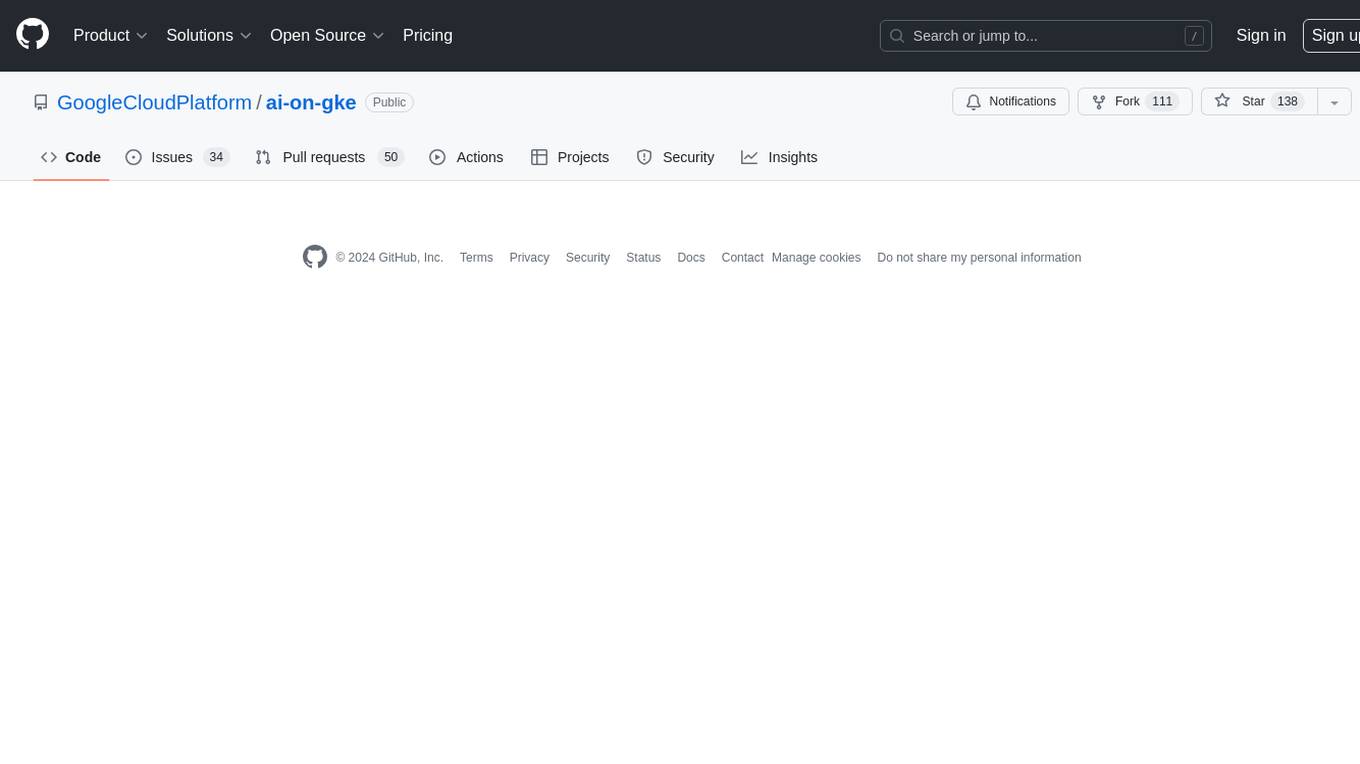
ai-on-gke
This repository contains assets related to AI/ML workloads on Google Kubernetes Engine (GKE). Run optimized AI/ML workloads with Google Kubernetes Engine (GKE) platform orchestration capabilities. A robust AI/ML platform considers the following layers: Infrastructure orchestration that support GPUs and TPUs for training and serving workloads at scale Flexible integration with distributed computing and data processing frameworks Support for multiple teams on the same infrastructure to maximize utilization of resources
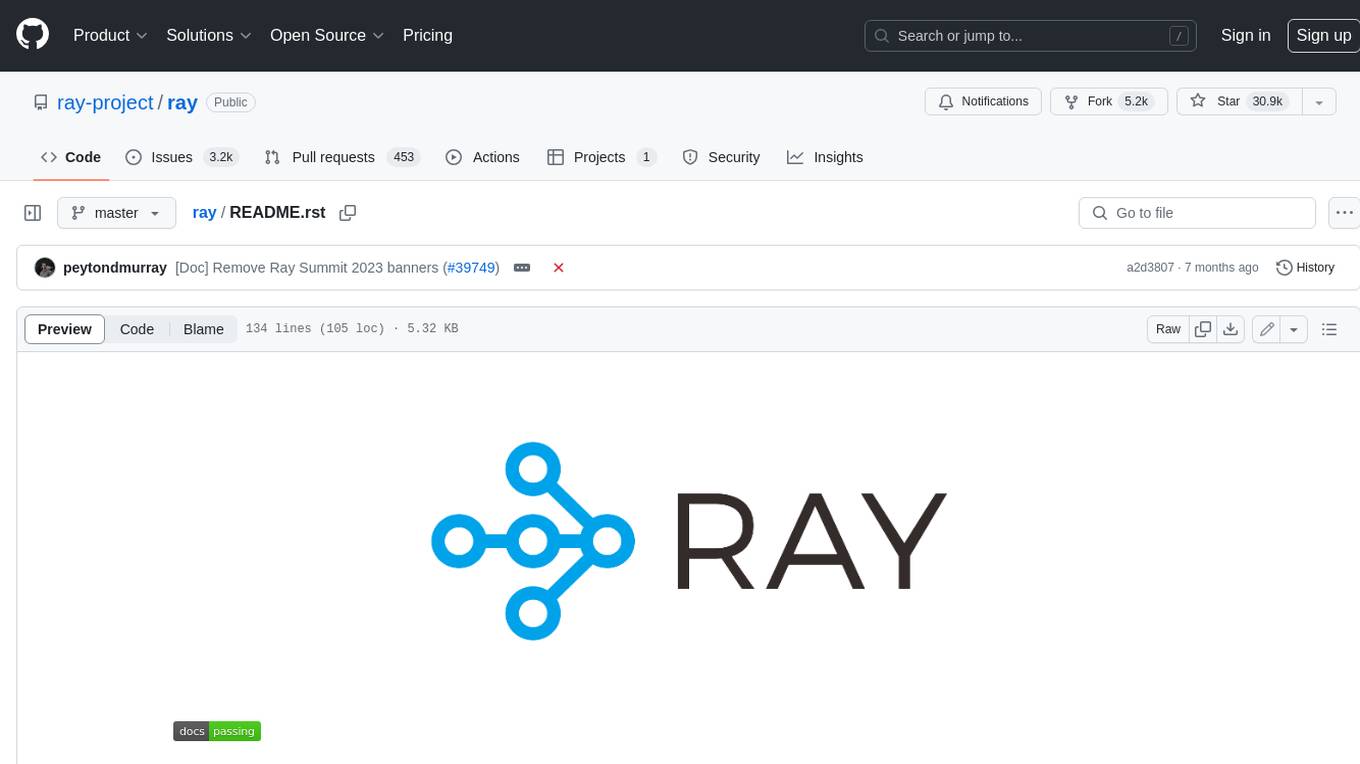
ray
Ray is a unified framework for scaling AI and Python applications. It consists of a core distributed runtime and a set of AI libraries for simplifying ML compute, including Data, Train, Tune, RLlib, and Serve. Ray runs on any machine, cluster, cloud provider, and Kubernetes, and features a growing ecosystem of community integrations. With Ray, you can seamlessly scale the same code from a laptop to a cluster, making it easy to meet the compute-intensive demands of modern ML workloads.

labelbox-python
Labelbox is a data-centric AI platform for enterprises to develop, optimize, and use AI to solve problems and power new products and services. Enterprises use Labelbox to curate data, generate high-quality human feedback data for computer vision and LLMs, evaluate model performance, and automate tasks by combining AI and human-centric workflows. The academic & research community uses Labelbox for cutting-edge AI research.
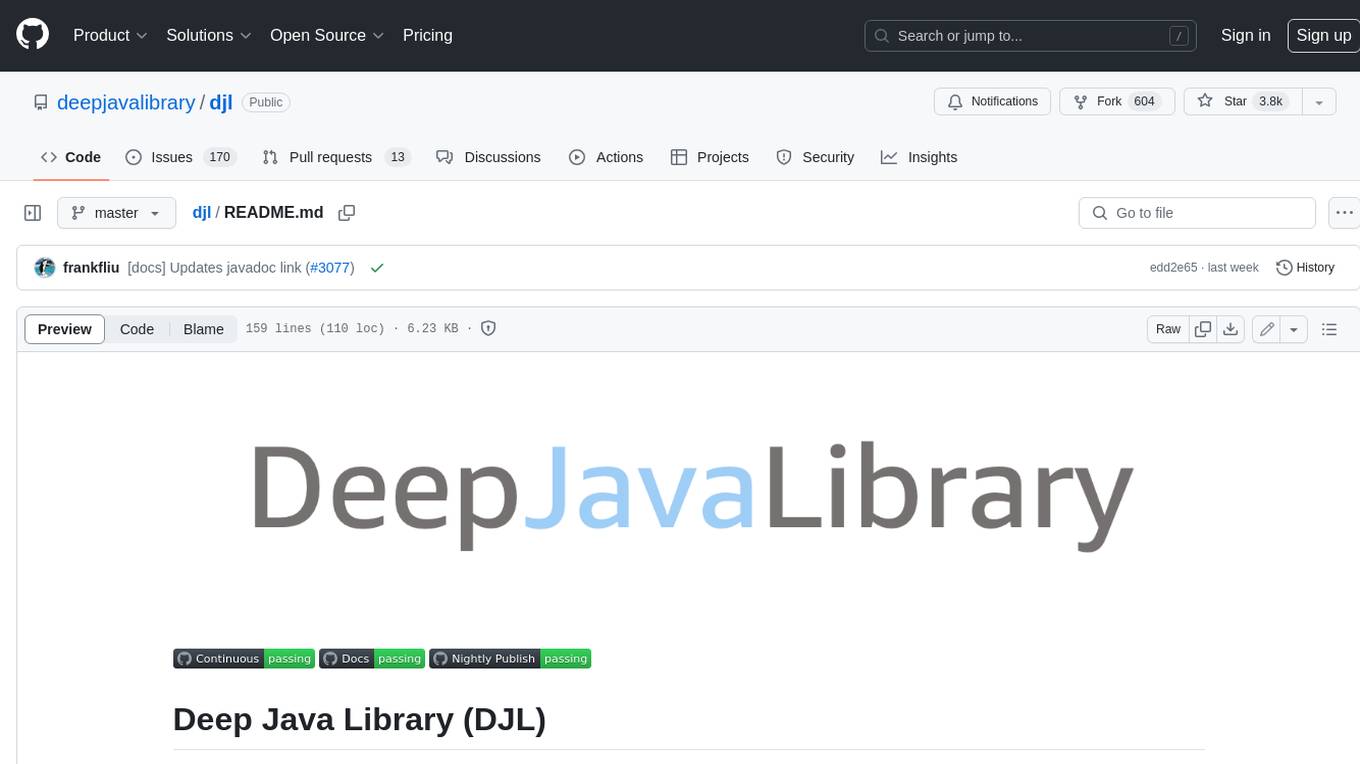
djl
Deep Java Library (DJL) is an open-source, high-level, engine-agnostic Java framework for deep learning. It is designed to be easy to get started with and simple to use for Java developers. DJL provides a native Java development experience and allows users to integrate machine learning and deep learning models with their Java applications. The framework is deep learning engine agnostic, enabling users to switch engines at any point for optimal performance. DJL's ergonomic API interface guides users with best practices to accomplish deep learning tasks, such as running inference and training neural networks.
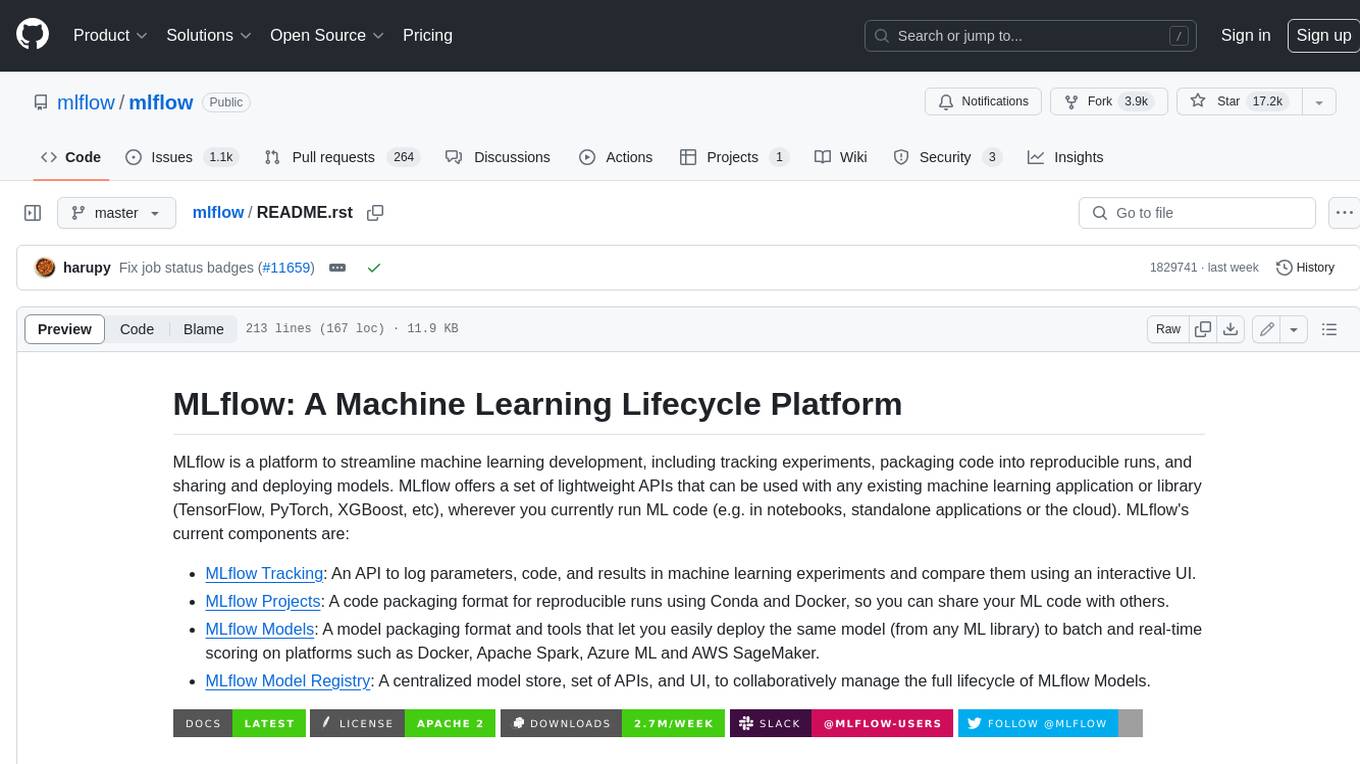
mlflow
MLflow is a platform to streamline machine learning development, including tracking experiments, packaging code into reproducible runs, and sharing and deploying models. MLflow offers a set of lightweight APIs that can be used with any existing machine learning application or library (TensorFlow, PyTorch, XGBoost, etc), wherever you currently run ML code (e.g. in notebooks, standalone applications or the cloud). MLflow's current components are:
* `MLflow Tracking

tt-metal
TT-NN is a python & C++ Neural Network OP library. It provides a low-level programming model, TT-Metalium, enabling kernel development for Tenstorrent hardware.

burn
Burn is a new comprehensive dynamic Deep Learning Framework built using Rust with extreme flexibility, compute efficiency and portability as its primary goals.
For similar jobs

sweep
Sweep is an AI junior developer that turns bugs and feature requests into code changes. It automatically handles developer experience improvements like adding type hints and improving test coverage.

teams-ai
The Teams AI Library is a software development kit (SDK) that helps developers create bots that can interact with Teams and Microsoft 365 applications. It is built on top of the Bot Framework SDK and simplifies the process of developing bots that interact with Teams' artificial intelligence capabilities. The SDK is available for JavaScript/TypeScript, .NET, and Python.

ai-guide
This guide is dedicated to Large Language Models (LLMs) that you can run on your home computer. It assumes your PC is a lower-end, non-gaming setup.

classifai
Supercharge WordPress Content Workflows and Engagement with Artificial Intelligence. Tap into leading cloud-based services like OpenAI, Microsoft Azure AI, Google Gemini and IBM Watson to augment your WordPress-powered websites. Publish content faster while improving SEO performance and increasing audience engagement. ClassifAI integrates Artificial Intelligence and Machine Learning technologies to lighten your workload and eliminate tedious tasks, giving you more time to create original content that matters.

chatbot-ui
Chatbot UI is an open-source AI chat app that allows users to create and deploy their own AI chatbots. It is easy to use and can be customized to fit any need. Chatbot UI is perfect for businesses, developers, and anyone who wants to create a chatbot.

BricksLLM
BricksLLM is a cloud native AI gateway written in Go. Currently, it provides native support for OpenAI, Anthropic, Azure OpenAI and vLLM. BricksLLM aims to provide enterprise level infrastructure that can power any LLM production use cases. Here are some use cases for BricksLLM: * Set LLM usage limits for users on different pricing tiers * Track LLM usage on a per user and per organization basis * Block or redact requests containing PIIs * Improve LLM reliability with failovers, retries and caching * Distribute API keys with rate limits and cost limits for internal development/production use cases * Distribute API keys with rate limits and cost limits for students

uAgents
uAgents is a Python library developed by Fetch.ai that allows for the creation of autonomous AI agents. These agents can perform various tasks on a schedule or take action on various events. uAgents are easy to create and manage, and they are connected to a fast-growing network of other uAgents. They are also secure, with cryptographically secured messages and wallets.

griptape
Griptape is a modular Python framework for building AI-powered applications that securely connect to your enterprise data and APIs. It offers developers the ability to maintain control and flexibility at every step. Griptape's core components include Structures (Agents, Pipelines, and Workflows), Tasks, Tools, Memory (Conversation Memory, Task Memory, and Meta Memory), Drivers (Prompt and Embedding Drivers, Vector Store Drivers, Image Generation Drivers, Image Query Drivers, SQL Drivers, Web Scraper Drivers, and Conversation Memory Drivers), Engines (Query Engines, Extraction Engines, Summary Engines, Image Generation Engines, and Image Query Engines), and additional components (Rulesets, Loaders, Artifacts, Chunkers, and Tokenizers). Griptape enables developers to create AI-powered applications with ease and efficiency.
